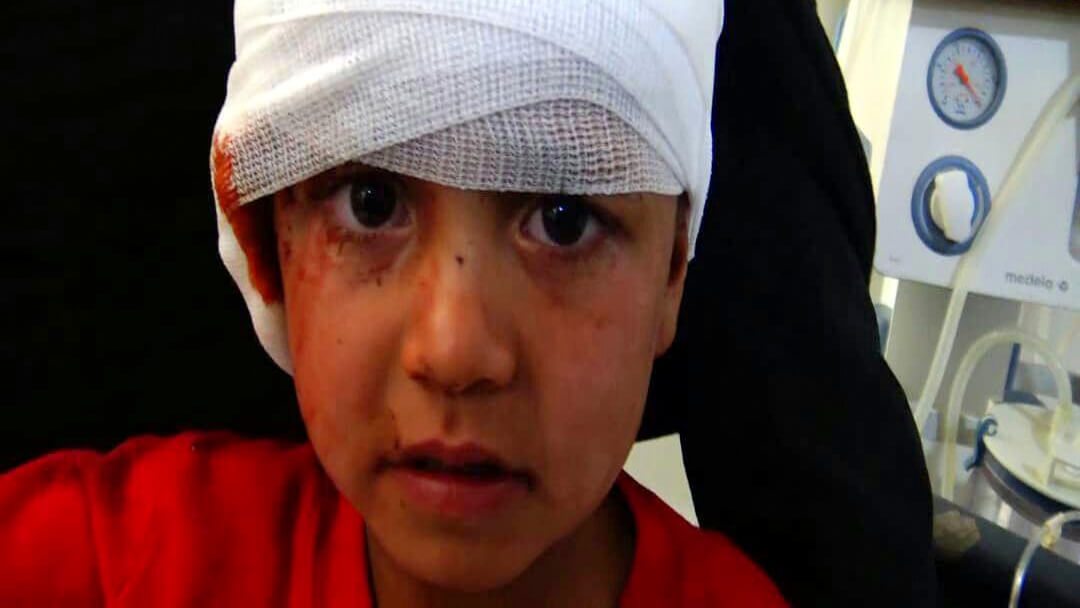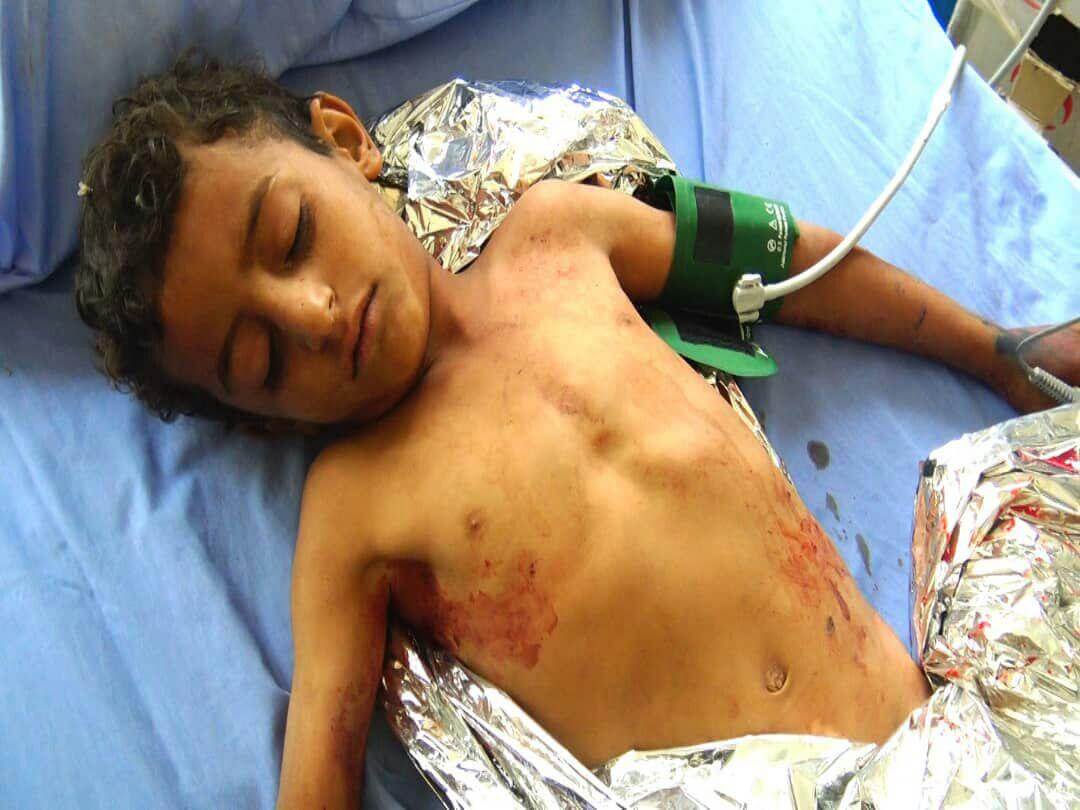Saudi Airstrike on Residential Neighborhood in Sadaa Kills 9 Civilians, Injures 5
Sadaa,Yemen — The U.S. backed Saudi-led coalition’s bloody campaign of airstrikes in Yemen continues to claim civilian victims. Yemen`s northern province as Sadaa, declared a military zone by the Saudi-led Coalition in the early days of its war on Yemen, is amongst the hardest-hit.
On Wednesday, a Saudi airstrike targeted a home serving as a de facto shelter for the internally displaced in the residential neighborhood of al-Seifi in Yemen’s northwestern province of Saada, killing nine civilians and injuring five, mostly women and children
Most of the victims belonged to the Khamlan family, who were seeking refuge in the home after fleeing the dangerous Baqim district. Six-year-old Ali Musfir Khamlan was among the few survivors of the airstrike. As volunteers began their frantic rescue efforts, he could be heard shouting, “I want my dad, I want mom.” Ali, a large white bandage wrapped around his head, had to be restrained as he continuously pleaded with paramedics to save his mother and father, both killed in the airstrike
Hussein, a 30-year-old resident of the area, told Mintpress that “two raids targeted the home, we pulled 9 people out of the rubble including Ali`s mother and father as well as three of his brothers. Most of the victims were women and children
Ali, along with two of his brothers, were among the six survivors of the airstrike. Doctors at the Al Jamouri hospital, which suffers from a shortage of medical supplies, are working to save the lives of Ali’s relatives, both of his brothers sustained injuries to their head, spine, and jaw and need treatment not available in Yemen

Six-year-old Ali Musfir Khamlan is treated at the Al Jomouri Hospital in Sadaa. Photo | Ahmed AbdulKareem
An emergency room doctor at the Al Jomouri Hospital told MintPress,
We received six wounded, most of them with very serious injuries, but we don’t have the advanced medical equipment needed to perform operations and we’re suffering from alack of medical staff and medicine.”
Ali, who whisked away by an ambulance crew while frantically searching the rubble for the dismembered head of his mother in a vain attempt to reattach it to her body, was already well-acquainted with the Saudi-coalition’s indiscriminate bombing campaign. He and his family were seeking refuge in the al-Seifi home after Saudi warplanes bombed their family home in the Baqim district located in Yemen’s mountainous northwestern province of Saada. That strike killed or injured ten members of Ali’s family
As Ali’s 45-year-old aunt recounted, “my brother’s family fled their neighborhood in Baqim after Saudi airstrikes destroyed their house and killed many of our family members, only three children have survived the two bombings
In the room opposite of the Al Jomouri Hospital emergency room where Ali’s family members were being treated, injured patients lie motionless in their beds as doctors and medical staff frantically made their way from one person to the next, attending to victims of a separate Saudi attack on the Mandy neighborhood that occurred just three days before
In Monday’s attack in Mandy, at least three children were killed and others injured when Saudi artillery units launched an indiscriminate attack on the residential neighborhood located in the Shada’a district, 60 kilometers north-west of the central Sadaa. Border areas in Sadaa are under almost daily rocket and artillery bombardment, often leaving scores of civilians dead or wounded, and causing extensive property damage
On Wednesday Saudi jets also pounded a number of homes in the town of Zabid in Yemen’s western coastal province of Hodeida, killing at least seven people. In addition, one civilian was killed and five others injured in a separate Saudi bombing in the al-Garrahi district of Hodeida province
Over 577 civilians, mostly women and children, have been killed or wounded in the first half of 2018 by U.S. backed Saudi airstrikes and artillery attacks in Saada according to a statement by local authorities to MintPress. That number could be much higher as only it only includes victims able to reach a hospital
On Jul 3, UNICEF executive director Henrietta Fore said in a statement to journalists in Geneva that over 2,200 children have been killed and 3,400 others injured during the three-year war on Yemen. “These are only numbers we have been able to verify, the actual figures could be even higher,” Fore confirmed
In addition to the aggressive bombing campaign led by Saudi Arabia and the United Arab Emirates, and supported by the United States and the United Kingdom, the coalition’s blockade of Yemen by land, sea and air has left more than 12 million people without wheat and other essential food staples. The combination of the blockade and a bombing campaign targeting Yemen’s electrical grid has left nearly 15 million people without access to health care, and 10 million people risk losing access to potable water
Watch | Saudi Arabia Bombs Residential Neighborhood in Yemen Killing Entire Family
A Saudi-coalition bombing targeted a residential neighborhood in Amran, Yemen, killing 15 civilians mostly women and children.
Imperialism, Intervention, “War On Terror” Detonate In Mogadishu
The recent devastating car bombing in Mogadishu has been blamed by Somali officials on the terrorist group al-Shabab. But the violence (and famine) that have beset Somalia have deeper roots — decades of imperialism and intervention, and use of Somalia as a staging grounds for the “war on terror.”
A Culture Of Violence: A Parade of Stephen Paddocks With A Huge Pile Of Guns
Buried among statistics on gun profits and lobbying efforts is the terrifying reality of just how unique America’s gun obsession and associated violence are. And the equally terrifying plan by the NRA to “normalize” gun possession in nearly every nook and cranny of American life.
Media On North Korea: Easier To Demonize Than Try To Understand
U.S. campaigns for regime change characteristically focus on the “madness” of the “dictators” to be toppled. In the case of North Korea, the narrative is spiced by the country’s developing nuclear capabilities — which North Korea views as its main line of defense against . . . regime change.




